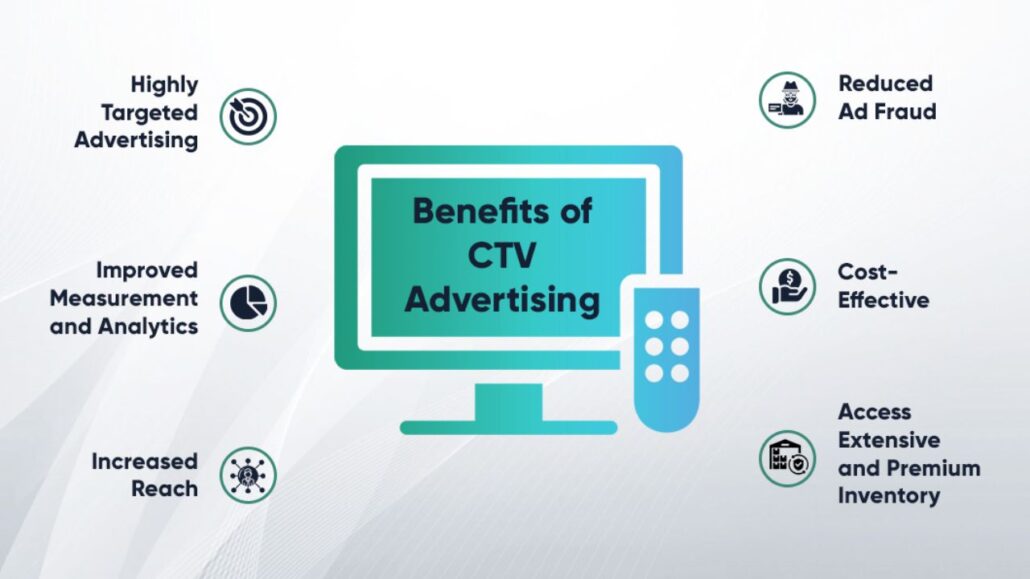In digital marketing, CTV, or Connected TV, refers to internet-connected televisions that can access online content. It includes smart TVs, streaming devices, and gaming consoles.
CTV allows for precise audience targeting and interactive engagement, revolutionising advertising strategies.
This technology offers measurable results, reduced ad fraud, and extensive cross-device reach, making it a powerful tool for marketers.
What is CTV?
Connected TV, or CTV, refers to any television connected to the internet and access content beyond traditional cable or satellite TV channels.
These devices include smart TVs, streaming devices (like Roku, Apple TV, and Amazon Fire Stick), gaming consoles, and even Blu-ray players.
CTV allows viewers to stream content from various online platforms like Netflix, Hulu, and YouTube.
How Does CTV Work?
CTV operates through an internet connection, giving viewers access to a wide range of content through streaming services.
Instead of relying on traditional broadcast or cable signals, CTV relies on internet protocols to deliver content.
This means that viewers can watch shows, movies, and videos on-demand, at their own pace, and on their preferred devices.
The Growth of CTV
The adoption of Connected TV has seen exponential growth in recent years. With the rise of streaming platforms like Netflix, Hulu, and Amazon Prime, viewers increasingly turn to CTV for entertainment.
According to a report by eMarketer, CTV penetration is expected to reach over 60% of the US population by 2022. This presents a significant opportunity for advertisers to tap into this expanding audience base.
Benefits of CTV in Digital Marketing

Precise Targeting Capabilities
One of the key advantages of CTV advertising is its ability to target specific demographics and user behaviours.
Through data analytics and audience segmentation, advertisers can deliver personalised content to viewers based on age, location, interests, and online behaviour.
This precision targeting ensures your message reaches the right audience at the right time.
Enhanced Engagement and Interactivity
Unlike traditional TV advertising, CTV offers interactive features that allow viewers to engage with the content in real time.
This can include clickable calls-to-action, interactive surveys, and even e-commerce integrations.
These interactive elements create a more immersive experience, increasing viewer engagement and potentially leading to higher conversion rates.
Measurable Results
CTV provides detailed analytics and metrics that enable advertisers to track the performance of their campaigns.
This includes metrics like ad viewability, click-through rates, completion rates, and more. These insights offer valuable feedback that can be used to optimise future campaigns for better results.
Cross-Device Reach
With CTV, advertisers can reach audiences across various devices, from smart TVs to mobile phones and tablets.
This multi-device reach ensures that your message is accessible to viewers regardless of their preferred screen size or platform.
Reduced Ad Fraud
CTV operates in a closed ecosystem, meaning it is less susceptible to ad fraud than other digital advertising channels.
This provides a level of security and transparency that advertisers highly value.
Implementing CTV in Your Digital Marketing Strategy
Now that we’ve explored the benefits of CTV let’s discuss how you can incorporate it into your digital marketing strategy:
Your Audience
Begin by conducting thorough audience research to gain insights into your target audience’s preferences, behaviours, and demographics. This information will be crucial for crafting personalised CTV campaigns.
Create Compelling Content
Develop high-quality, engaging video content that resonates with your target audience. Consider leveraging interactive elements to enhance viewer engagement.
Leverage Data and Analytics
Utilise data analytics to refine your targeting strategy and measure the performance of your CTV campaigns. This iterative approach will help you optimise your campaigns for better results.
Collaborate with CTV Platforms and Providers
Partner with CTV platforms and providers to ensure your ads are delivered effectively and reach your desired audience segments.
Stay Updated with Industry Trends
Keep an eye on emerging technologies and trends in the CTV space to stay ahead of the competition and leverage new opportunities.
Where are connected TV ads shown?
Connected TV ads are displayed on internet-connected television screens.
This includes smart TVs, streaming devices (such as Roku, Apple TV, and Amazon Fire Stick), gaming consoles, and even Blu-ray players.
Viewers access content from various online platforms like Netflix, Hulu, YouTube, and more, making it a prime space for advertisers to reach their target audience.
How does CTV advertising work?
CTV advertising works by delivering video content to viewers through internet-connected television devices.
Advertisers create and upload their video content, which is then delivered to the selected audience through CTV platforms.
These ads can be shown before, during, or after the streaming content, providing an opportunity for brands to engage with their audience in a relevant and engaging manner.
CTV Marketing Best Practice
Effective CTV marketing involves several best practices. These include understanding your target audience, creating compelling and relevant content, utilising data for precise targeting, optimising for different devices, and measuring campaign performance.
Additionally, incorporating interactive elements and staying updated with industry trends are crucial for success in CTV marketing.
Important metrics and measures for CTV advertising
Key metrics for evaluating CTV advertising performance include ad viewability, completion rates, click-through rates (CTR), reach and frequency, and return on ad spend (ROAS).
Tracking engagement metrics like interactions with interactive elements, such as clickable calls-to-action, can provide valuable insights into viewer behaviour and campaign effectiveness.
How are connected TV audiences targeted?
Connected TV audiences are targeted through a combination of demographic and behavioural data.
Advertisers can leverage data from CTV platforms and third-party sources to create audience segments based on age, gender, location, interests, and online behaviour.
These segments then deliver personalised content to specific viewer groups, ensuring the message resonates with the intended audience.
How to buy CTV advertising?

Advertisers typically work with CTV platforms or programmatic advertising platforms to buy CTV advertising.
They can choose from various ad formats (pre-, mid-, or post-roll), set their targeting parameters, and define their budget.
Advertisers can also opt for private marketplaces or direct deals with publishers. Working closely with CTV platform providers to optimise campaigns for maximum effectiveness and reach is important.
CTV in Digital Marketing: CTV, or Connected TV, refers to delivering television content over the internet through smart TVs or streaming devices. In digital marketing, CTV provides a platform for advertisers to target and engage audiences with video ads on these connected devices, expanding their reach beyond traditional TV broadcasting.
CTV Advertising Meaning: CTV advertising is a digital marketing strategy that involves placing video ads on connected TV platforms. It allows businesses to reach a highly engaged audience through streaming services and smart TVs. CTV advertising delivers targeted content to viewers while optimizing ad performance and adhering to best practices to maximize effectiveness.
Connected TV (CTV) Advertising: Connected TV (CTV) advertising refers to the digital advertising method that targets viewers of television content streamed over the internet on smart TVs or other devices. It allows advertisers to deliver tailored messages to specific audiences, leveraging data and technology for more precise targeting and measurement than traditional TV advertising.
CTV Optimizing: CTV optimizing involves the process of refining and enhancing connected TV advertising campaigns to achieve better performance and results. This may include adjusting targeting parameters, creative elements, budget allocation, and other campaign settings based on data-driven insights and key performance indicators (KPIs).
CTV Advertising Examples: Examples of CTV advertising include campaigns run on popular streaming platforms like Hulu, Netflix, Amazon Prime Video, and YouTube TV. These ads can take various forms, such as pre-roll video ads, interactive overlays, display banners, and more. They are typically delivered to viewers during breaks in the content they are streaming.
Define Connected TV: Connected TV (CTV) refers to the technology that enables television sets to access content via an internet connection rather than through traditional broadcast or cable/satellite transmission. CTV devices include:
- Smart TVs.
- Streaming media players (e.g., Roku, Apple TV).
- Gaming consoles.
- Other platforms that allow viewers to stream digital content on their TV screens.
CTV Definition in Marketing: In marketing, Connected TV (CTV) refers to a digital advertising channel that delivers video content to viewers through internet-connected television sets or devices. It allows advertisers to reach specific audiences with targeted messages while leveraging the interactivity and measurement capabilities of digital advertising.
CTV Ad Fraud: CTV ad fraud refers to deceptive activities aimed at exploiting the CTV advertising ecosystem. This can include fraudulent practices like fake impressions, spoofed domains, or bots mimicking human behaviour to generate false ad views, potentially leading to wasted ad spend and skewed performance metrics.
Meaning of CTV: CTV stands for Connected TV. It refers to televisions connected to the internet, allowing viewers to access and stream digital content from various online platforms and services.
What Does CTV Stand for in Advertising: In advertising, CTV stands for Connected TV. It represents the technology and platform that allows viewers to stream digital content on their television sets through an internet connection, opening up new opportunities for targeted advertising.
CTV Best Practices: CTV best practices encompass strategies and guidelines for creating and executing effective connected TV advertising campaigns. These may include audience targeting based on demographic and behavioural data, engaging and relevant creative content, optimizing ad placements, and employing advanced measurement techniques to track campaign performance and ROI.
Conclusion:
Connected TV represents a powerful tool in the digital marketing toolkit, offering precise targeting, enhanced engagement, and measurable results.
By incorporating CTV into your marketing strategy, you can effectively reach and engage your target audience in the ever-evolving digital landscape.
Stay informed, adapt to changing trends, and unlock your brand’s full potential for CTV.
FAQ:
What is the meaning of CTV?
CTV stands for Connected TV. It refers to any television that can connect to the internet and access content beyond traditional cable or satellite TV channels.
What are CTV advertising examples?
CTV advertising includes commercials on streaming services accessed through devices like smart TVs, Roku, Apple TV, etc. For example, ads on Hulu or YouTube TV are considered CTV advertising.
What are CTV and OTT?
CTV (Connected TV) refers to internet-connected televisions, while OTT (Over-the-Top) refers to streaming services that deliver content directly over the internet, bypassing traditional cable or satellite providers.
CTV is the device, and OTT is the content delivery method.
What are the different types of CTV?
The different types of CTV devices include smart TVs, streaming devices (like Roku, Apple TV, etc.), gaming consoles, and some Blu-ray players.
What is a CTV application?
CTV applications are software programs run on Connected TV devices, allowing users to access streaming services like Netflix, Hulu, YouTube, and more.
Does YouTube count as CTV?
YouTube is not a CTV platform, but it can be accessed through CTV devices like smart TVs, making it available for viewing on television. So, it can be considered a part of the CTV ecosystem.



